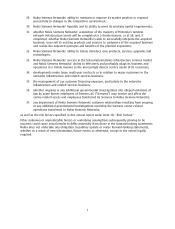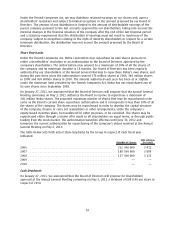Nokia 2010 Annual Report Download - page 15
Download and view the complete annual report
Please find page 15 of the 2010 Nokia annual report below. You can navigate through the pages in the report by either clicking on the pages listed below, or by using the keyword search tool below to find specific information within the annual report.increased monetization opportunities for us in services and intellectual property rights, may
not materialize as expected, or at all.
• The opportunity to integrate our locationbased assets, including NAVTEQ, with Microsoft’s Bing
search engine and adCenter advertising platform and leverage those combined assets to form a
local search and advertising capability that generates new sources of revenue for us may not
materialize as expected, or at all. This could also decrease the value of our locationbased
assets that might result in impairment charges.
• We may not succeed in leveraging the Microsoft advertising assets to build and achieve the
required scale for a Nokiabased online advertising platform on our smartphones that
generates new sources of advertisingbased revenue.
• We may not succeed in creating a profitable business model when we transition from our
royaltyfree smartphone platform to the royaltybased Windows Phone platform due to, among
other things, our inability to offset our higher cost of sales resulting from our royalty payments
to Microsoft with new revenue sources and a reduction of our operating expenses, particularly
our research and development expenses.
• We will need to continue to innovate and find additional ways to create patentable inventions
and other intellectual property, particularly as we would no longer be developing the core
platform technology for our smartphones under the proposed Microsoft partnership. As a
result, we may not be able to generate sufficient patentable inventions or other intellectual
property to maintain, for example, the same size and/or quality patent portfolio as we have
historically.
• We may not be able to change our mode of working or culture to enable us to work effectively
and efficiently with Microsoft in order to realize the stated benefits of the proposed
partnership in a timely manner.
• The negotiation and implementation of the proposed Microsoft partnership will require
significant time, attention and resources of our senior management and others within the
organization potentially diverting their attention from other aspects of our business.
• The proposed Microsoft partnership may cause dissatisfaction and adversely affect the terms
on which we do business with our other partners, mobile operators, distributors and suppliers,
or foreclose the ability to do business with new partners, mobile operators, distributors and
suppliers.
• The implementation of the proposed Microsoft partnership may cause disruption and
dissatisfaction among employees reducing their motivation, energy, focus and productivity,
causing inefficiencies and other problems across the organization and leading to the loss of
key personnel and the related costs in dealing with such matters.
• We may not have or be able to recruit, retain and motivate appropriately skilled employees to
implement successfully the Windows Phone smartphone platform and to work effectively and
efficiently with Microsoft and the related ecosystem.
• We may be required or choose to share with Microsoft personal or consumer data that has
been made available to us, which could increase the risk of loss, improper disclosure or
leakage of such personal or consumer data or create negative perceptions about our ability to
maintain the confidentiality of such data.
• Consumers may be more reluctant to provide personal data to us as a result of the proposed
Microsoft partnership, which would hamper our ability to use our current business models, or
create new ones, that rely on access to personal data.
• We do not currently have tablets in our mobile product portfolio, which may result in our
inability to compete effectively in that market segment in the future or forgoing that potential
growth opportunity in the mobile market.
14
























